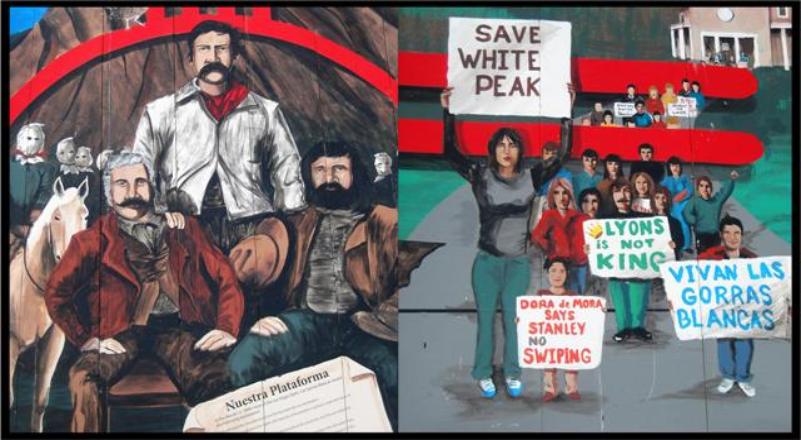Continues from Page 1… Contemporary Las Vegas in el norte de New Mexico occupies a portion of the Las Vegas Grandes Land Grant, established in 1835 as an Hispano community grant, with a confirmed 431,653 acres. Most of the events connected to the conquest of New Mexico by General Kearney in 1846 occurred in northern New Mexican towns. Today Kearney’ s occupation proclamation is memorialized in a plaque standing on one side of the Las Vegas plaza, a legacy of our colonized status.
Currently, the land grant concept is still perceived by La Raza in el norte as a nurturing la tierra, the nurturing mother and the giver of life. Grants are historically characterized by overlapping collective and individual land practices and access to resources including water. Generational ties between family and community, spirituality, and the Spanish language formed the cultural base of these ancestral lands. Through the grant system, relative self sufficiency and collective resilience to adversity was possible. The concept of the grant is linked to the collective ancestral, indigenous landed communities, existing when there were no borders between the native populations of the Americas.
The beginning of the demise of the grants came in the form of land grabs during 19th century Westward Expansion. This loss accelerated with several events, the annexation of Aztlan, now the Southwest, into the American Union, the infamous disregard of the Treaty of Guadalupe Hidalgo of 1848, the coming of the railroad that brought capitalism to the region, and the cordoning off of lands by the Forest Service and environmental restrictions to access.
Hispano poverty and economic hardship that came with the general collapse of the agrarian system left a wide playing field for real estate designs, and an influx of non-Hispano outsiders.
A connection between past and present
Currently, what remains of ancestral land legacies continues to fade. Much of this is attributed to monied gentrification that profits from land rich but cash poor Hispanos. In a recent interview, Rock Ulibarri, artist and coordinator of the Las Vegas mural, writer, educator, people’s historian, and community leader, linked the Las Vegas mural to the continued people’s struggle to keep the land that remains. Litigation for lost lands and accessibility to resources continues.
Painted by multicultural youth of the community and directed by Rock, the mural is a chronological people’s story of injustice and struggle, underlined by the disastrous Westward Expansion. Inspired by Howard Zinn’s approach to grassroots history, and based on a community survey taken to explore the most popular themes to be included in the mural, Rock described the creation of the latter as an educational tool, used to enlighten our youth about their history and culture. History becomes more relevant if it is about you.
Because of this, he added, there appears to exist an ownership undercurrent on the part of the youth and the general community. To date, the mural bears no markings of vandalism. The People’s History of El Norte mural validates the experiences of past generations, a counter to the Eurocentric textbook portrayal of el norte generally used in schools. The mural is a moveable collection, designed in this manner to prevent a repetition of the disappearance, through whitewashing and construction, of murals created in Las Vegas during the Movimiento.
For Rock, the relationship of the mural to our fast disappearing lands is perceived as a way to promote awareness of the connection between past and present, prompting us to ask, “How did we lose our land and how have we kept the land we have?” “What patterns are being repeated? If you have no sense of your history then you can’t recognize when things are happening again.” With no sense of self or place there is no cultural clarity. Embedded in these musings is orgullo, a pride that encourages youth, our next generation of leaders, to “carry the torch,” continuing the pride of the older generations and the struggle for justice.
The New Mexico mural, a powerful sense of collective effort
In this part of Aztlan, as in southern Colorado, we are pridefully empowered by a resilient history of struggle against land theft and injustice. This empowerment is enshrined in the activities of Las Gorras Blancas, Reies López Tijerina and La Alianza Federal de Mercedes, and the Movimiento. Despite encroachment, empowerment in el norte means a sense of continuity, living in the home and on the land of your ancestors. A sense of historical place holds cultural memory and creates traditions and roots.
Since the invasion of Mexico in the 16th century, our values, culture, language and land have been relentlessly and systematically attacked by formal, informal, overt and covert colonization. This invasion propelled us from a communal approach to one of dependency on consumerism and individuation. We are seeing the consequences of this today in the downward spiral of our economy.
Yet, Casa de Cultura, Rock Ulibarri, and the youth of the community have created, through the mural, a powerful sense of collective effort in Las Vegas and a teaching tool for tourists that come to our town. It may help the latter to understand that el norte is not embodied in the images of Teddy Roosevelt and the Rough Riders, ironically, icons in Las Vegas. La gente has their own dynamic story that speaks of resiliency in the face of past and present encroachment. Return to Page 1 →
© 2012 - 2024, Yoly Zentella. All rights reserved.





